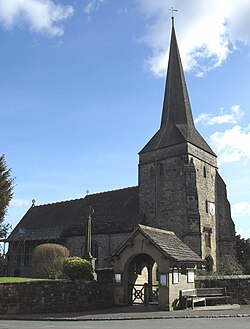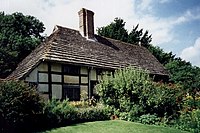West Hoathly
| West Hoathly | |
| Sussex | |
|---|---|
 St Margaret of Antioch, West Hoathly | |
| Location | |
| Grid reference: | TQ364329 |
| Location: | 51°4’48"N, 0°3’11"W |
| Data | |
| Population: | 2,181 (2011) |
| Post town: | East Grinstead |
| Postcode: | RH19 |
| Dialling code: | 01342 |
| Local Government | |
| Council: | Mid Sussex |
| Parliamentary constituency: |
Mid Sussex |
| Website: | Parish Council |
West Hoathly is a village in the north of Sussex, three and a half miles south-west of East Grinstead. The 2011 census recorded a population of 2,181 people. The village, an ancient hilltop settlement in the High Weald between the North and South Downs.
Contents
History
The area was already settled by the 11th century, when St Margaret's Church was founded. Names recorded at that time include Hadlega and Hodlega—later standardised to Hodlegh and Hothelegh, then (West) Hoathly. This is from the Old English Hæþleag, signifying a heath-covered clearing.[1][2] The parish lay on the edge of the dense woodland of the Ashdown Forest.[3]
At the time of the Domesday Book of 1086, the land covered by the present parish was held by the manors of Ditchling and Plumpton to the south-east. The rectory of the church was associated with Lewes Priory. By the 16th century, the manor of Gravetye was in existence.[1] Gravetye Manor house, built in 1598, still stands in extensive grounds a mile north of the village.[4]
In 1556, West Hoathly resident Ann Tree was burnt at the stake in East Grinstead for refusing to renounce Protestantism; she was one of 17 "Sussex Martyrs" who suffered this fate. A brass memorial in the church commemorates her.[2]
In 1624 a side from West Hoathly was involved in what is believed to be the earliest known organised cricket match in Sussex, which took place at Horsted Keynes.[5]
Railway connection
West Hoathly was connected to the railway network when the Lewes and East Grinstead Railway was built in 1882. A station, West Hoathly, was provided east of the village, between the village itself and Sharpthorne.
The line passed under a sandstone ridge by means of a 731-yard long tunnel.[1]
The line and station closed on 16 March 1958,[6] and the station stood derelict for many years, with the footbridge and down-platform buildings removed in 1964 and the station house demolished in 1967.[7] The preserved Bluebell Railway, (now eleven miles in length) runs along part of the route of the former Lewes and East Grinstead Railway. The West Hoathly station site was purchased by the Bluebell Railway on 30 November 1975,[8] and the line re-opened through the site in 1992, but the station itself otherwise remains disused.[9]
"Big-upon-Little"
"Big-upon-Little", also known as "Great-upon-Little", is a natural landscape formation in a wooded area south-west of the village, near the road to Ardingly. It is an exposed outcrop of sandstone with a harder band overlying a soft stratum at ground level. The lower stratum has weathered significantly, making the upper section overhang like the cap of a mushroom.[10]
Churches
- Church of England:
- St Margaret of Antioch, on North Lane in West Hoathly.[11]
- All Saints' Church in Highbrook
- Independent / evangelical: Sharpthorne Community Church in Sharpthorne (of the the ountess of Huntingdon's Connexion)
- Roman Catholic: St Dunstan's
St Margaret's has Norman origins, although much of the fabric of the building is 13th-century. The church has a tower with a Perpendicular Gothic broach spire, a single-aisled nave, a chancel and a side chapel.[12] The terraced churchyard is a well-known viewpoint, with far-reaching views across the Weald.[13]
All Saints Church at Highbrook was paid for by two wealthy local sisters who thought that church attendance among the hamlet's residence was being hampered by the long distance they had to travel to St Margaret's Church.[14] Architects Richard H. Carpenter and Benjamin Ingelow designed the large, stone-built church in 1884.[15][16] The churches have separate ecclesiastical parishes but are part of a united benefice, served by the same vicar.[17]
St Dunstan's Roman Catholic church is in West Hoathly. English Heritage describe the building as "a curiosity": it was a cottage with an attached butcher's shop until its conversion into a church in 1957.[18]
In Sharpthorne, the Countess of Huntingdon's Connexion—a small Nonconformist denomination with links to Methodism—has a place of worship, the Sharpthorne Community Church. It was founded by members of an older church in nearby Turners Hill.[19][20] There was also a Countess of Huntingdon's Connexion chapel at the north end of West Hoathly from 1826 until the early 21st century. The timber-framed building survives, but is disused.[1][21]
About the village
The parish has many mediæval houses and farms. The oldest is Tickeridge, near Selsfield Common and the preserved Kingscote railway station. Its modernised exterior hides a 14th-century timber-framed Wealden hall house of "high antiquarian interest".[22] The gabled solar wing dates from the 16th century.[1][22] Gravetye Manor, built in 1598, has an Elizabethan façade and was built for a local ironmaster: northern Sussex was an important ironmaking area for several centuries. Later abandoned to smugglers, the building and its grounds were rejuvenated in 1884 when "the greatest English gardener" William Robinson bought it.[23] He also designed the thirty-acre gardens. Upon his death in 1935 the manor, set in a large area of woodland, passed to the Forestry Commission for use as a base for their work. It was converted into a high-class restaurant in 1958.[1][24] Chiddinglye, which may have been a separate manor at one time,[1] is a Gothic house of 1866.[4] Next to it is Chiddinglye Farm, an open hall house with 15th- and 16th-century parts.[1] Selsfield House has a Georgian façade.[4]
The Priest House in the centre of the village opposite St Margaret's Church, was turned into a museum by the Sussex Archaeological Society in 1935.[25] The 15th-century open hall-house, with a five-bay façade and a solar wing, retains some original windows and its king post and trussed roof.[1][4] Items relating to local and domestic history are on display, and there are formal gardens.[25]
The village pub is the Cat Inn, housed in an early 16th-century timber-framed building with a tile and brick exterior. Original beams are still visible inside on both storeys.[1]
Near Sharpthorne, West Hoathly Pit is designated a Site of Special Scientific Interest. It is a working clay pit of geological interest with 30 feet of visible sedimentary layers.[26]
Sport
- Football: West Hoathly Football Club, founded in 1902
Jasper Vinall from West Hoathly was the first cricketer known to have been killed while playing the game. This happened on 28 August 1624 at Horsted Keynes,also in Sussex.
Outside links
| ("Wikimedia Commons" has material about West Hoathly) |
References
- ↑ 1.0 1.1 1.2 1.3 1.4 1.5 1.6 1.7 1.8 1.9 A History of the County of Sussex - Volume 7 pp 164=172: Parishes: West Hoathly (Victoria County History)
- ↑ 2.0 2.1 Syms 1994, p. 174.
- ↑ "The Parish of West Hoathly". West Hoathly Parish Council. 2010. http://www.westhoathly.gov.uk/index.html.
- ↑ 4.0 4.1 4.2 4.3 Nairn & Pevsner 1965, p. 627.
- ↑ McCann, pp. xxxiii–xxxiv.
- ↑ Gough 1993, p. 120.
- ↑ Marx 2000, p. 198.
- ↑ Marx 2000, p. 235.
- ↑ Gough 1993, p. 125.
- ↑ Swinfen & Arscott 1984, p. 146.
- ↑ "St Margaret's Church, West Hoathly". St Margaret's Church, West Hoathly. 2010. http://www.westhoathly.org.uk/.
- ↑ Salter 2000, p. 143.
- ↑ Nairn & Pevsner 1965, p. 626.
- ↑ Allen, John (22 February 2010). "Highbrook – All Saints". Sussex Parish Churches website. Sussex Parish Churches (www.sussexparishchurches.org). http://www.sussexparishchurches.org/content/view/492/33/.
- ↑ Elleray 2004, p. 32.
- ↑ Nairn & Pevsner 1965, p. 538.
- ↑ "All Saints Church". Highbrook village website. Serious Systems. 2009–2010. http://www.highbrook.info/church.php.
- ↑ "English Heritage Review of Diocesan Churches 2005 (Extract): St Dunstan, West Hoathly, West Sussex". English Heritage. 2005. http://www.dabnet.org/Resources/DABNet/English%20Heritage%20Reports%20Extracts/West%20Hoathly%20EH.pdf.
- ↑ "Church Websites: The Countess of Huntingdon's Connexion Churches". New Connexions. 2006. http://www.newconnexions.org.uk/churches.html.
- ↑ "Connexional Churches in the South East". Countess of Huntingdon's Connexion. 2009. http://www.zoetic.eu/cohc/mapse.html.
- ↑ Elleray 2004, p. 55.
- ↑ 22.0 22.1 Nairn & Pevsner 1965, p. 628.
- ↑ Wales 1999, pp. 229–230.
- ↑ "West Hoathly". Mid Sussex District Council. 2010. http://www.midsussex.gov.uk/page.cfm?pageid=2154.
- ↑ 25.0 25.1 Swinfen & Arscott 1984, p. 147.
- ↑ SSSI listing and designation for West Hoathly
- Elleray, D. Robert (2004). Sussex Places of Worship. Worthing: Optimus Books. ISBN 0-9533132-7-1.
- Gough, Terry (1993). British Railways Past and Present No. 18: Surrey and West Sussex. Past and Present Railways Collection. Wadenhoe: Past and Present Publishing Ltd. ISBN 1-85895-002-3.
- McCann, Tim (2004). Sussex Cricket in the Eighteenth Century. Sussex Record Society.
- Marx, Klaus (2000). An Illustrated History of the Lewes & East Grinstead Railway. Shepperton: Oxford Publishing Co. ISBN 0-86093-547-7.
- Nairn, Ian; Pevsner, Nikolaus (1965). The Buildings of England: Sussex. Harmondsworth: Penguin Books. ISBN 0-14-071028-0.
- Salter, Mike (2000). The Old Parish Churches of Sussex. Malvern: Folly Publications. ISBN 1-871731-40-2.
- Swinfen, Warden; Arscott, David (1984). Hidden Sussex. Brighton: BBC Radio Sussex. ISBN 0-9509510-0-5.
- Syms, James Antony (1994). East Sussex Country Churches. Seaford: S.B. Publications. ISBN 1-85770-056-2.
- Wales, Tony (1999). The West Sussex Village Book. Newbury: Countryside Books. ISBN 1-85306-581-1.

